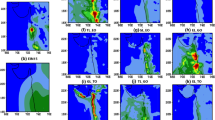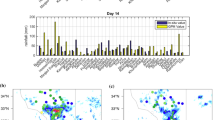Abstract
High-impact mesoscale weather events, occurring in different parts of India in all seasons, lead to major weather- and climate-related disasters. Several research groups and operational weather forecasting centres in India have adopted mesoscale models for research and operational usage. This paper reviews the work done by different groups with respect to two specific events, (1) unprecedented locally heavy rainfall near Mumbai (Santa Cruz) on 26 and 27 July 2005 and (2) the Orissa super-cyclone of 29 and 30 October 1999 from its incipient stage on 24 and 25 October 1999. Considerable variability in the prediction of the intensity and location of mesoscale heavy rainfall, as well as in the intensity and path of the super-cyclone, are found. In order to reduce uncertainty in dynamical prediction, it is necessary that the model dynamics, physics, resolution, boundary conditions and availability of data on land–ocean surface processes are tuned separately to the specific event types, such as heavy monsoon rainfall, tropical cyclone genesis and movement and severe local thunderstorms, as the processes controlling such types of events may require suitable treatments for their proper simulations through appropriate dynamics, physics and resolution.






Similar content being viewed by others
References
Ashrit RG, Dasgupta M, Bohra AK (2006) MM5 simulation of the 1999 Orissa Super Cyclone: impact of bogus vortex on track and intensity predictions. Mausam 57:129–134
Bhaskar Rao DV, Prasad DH (2006) Numerical prediction of the Orissa Super Cyclone (1999): sensitivity to the parameterization of convection, boundary layer and explicit moisture processes. Mausam 57:61–78
Bohra AK, Basu S, Rajagopal EN, Iyengar GR, Dasgupta M, Ashrit R, Athiyaman B (2005) Heavy rainfall episode over Mumbai on 2 July 2005: assessment of NWP guidance. Report of NCMRWF, August 2005
De US, Dutta S (2005) West Coast rainfall and convective instability. J Indian Geophy Union 9:71–82
Dudhia J (1993) A non-hydrostatic version of the Penn State NCAR mesoscale model: validation test and simulation of an Atlantic cyclone and cold front. Mon Weather Rev 121:1493–1513
Francis PA, Gadgil S (2006) Intense rainfall events over the west coast of India. Meteorol Atmos Phys 94:27–42, DOI 10.1007/s00703-005-0167-2
Goswami P, Mandal A, Upadhyaya HC, Hourdin F (2006) Advance forecasting of cyclone track over north Indian Ocean using a global circulation model. Mausam 57:111–118
Grossman RL, Durran DA (1984) Intensification of low level flow with the Western Ghat mountains and offshore convection in the summer monsoon. Mon Weather Rev 112:652–667
Jenamani RK, Bhan SC, Kalsi SR (2006) Observational/forecasting aspects of the meteorological event that caused record highest rainfall of 94.4 cm on 26–27 July 2005 in Mumbai. Current Sci 90:1344–1362
Kalsi SR (2006) Orissa Super Cyclone—a synthesis. Mausam 57:1–20
Kalsi SR, Srivastava KB (2006) Characteristic features of Orissa Super Cyclone of 29 October 1999 as observed through CDR Paradip. Mausam 57:21–30
Kar SC, Rupa K, Dasgupta M, Singh SV (2003) Analysis of Orissa Super Cyclone using TRMM (TMI), DMSP (SSM/I) and OCEANSAT-1 (MSMR) derived data. Global Atmos Ocean Sys 9:1–18
Krishnamurti TN, Patnaik S, Stefnova I, Vijaykumar TSS, Mackey BP, O’shay AJ, Pasch RJ (2005) On the hurricane intensity issue. Mon Weather Rev 133:1886–1912
Mandal M, Mohanty UC (2006) Numerical experiments for the improvement in mesoscale simulation of Orissa Super Cyclone. Mausam 57:79–96
Mausam (2006) Special issue on Orissa Super Cyclone of October 1999. Mausam 57:1–165
Miller FR, Keshavmurty RN (1968) Structure of an Arabian monsoon system. IIOE Met Monograph, East West Centre Press, Hawaii
Mohanty UC, Mandal M, Raman S (2004) Simulation of Orissa Super Cyclone (1999) using PSU/NCAR mesoscale model. Nat Hazards 31:373–390
Mukherjee AK, Rao MK, Shah KC (1978) Vortices embedded in the trough of low pressure off Maharashtra–Goa coasts during the month of July. Indian J Met Hydrol Geophy 29:61–65
Mukherjee AK, Kumar S, Krishnamurthy G (1984) The dynamics of the offshore vortex in the east Arabian Sea and its associated rainfall. Indian J Met Geophys 35:233–234
Ogura Y, Yoshizaki M (1988) Numerical study of orographic convective precipitation over the eastern Arabian Sea and the Ghat mountains during summer monsoon. J Atmos Sci 45:2097–2122
Pielke RA, Cotton WR, Walke RL, Trenback CJ, Lyones WA, Grasso LD, Nichols ME, Moran MD, Wesley DA, Lee TJ, Copelan JH (1992) A comprehensive modeling system, RAMS. Meteorol Atmos Phys 49:6951
Sarker RP (1966) A dynamical model of orographic rainfall. Mon Weather Rev 94:555–572
Sarker RP (1967) Some modifications in a dynamical model of orographic rainfall. Mon Weather Rev 95:673–684
Shivhare RP, Srinivas VS (2006) Tropical cyclonic storms—modeling studies in Indian Air Force. Mausam 57:135–140
Singh R, Pal PK, Kishtwal CM, Joshi PC (2005) Impact of bogus vortex for track and intensity prediction of tropical cyclone. J Earth Sys Sci 114:427–437
Smith RB, Yuh-Lang Lin (1982) The addition of heat to stratified air stream with application to dynamics of orographic rains. Q J R Meteorol Soc 108:353–378
Trivedi DK, Sanjay J, Singh SS (2002) Numerical simulation of a super cyclonic storm, Orissa, 1999—impact of initial conditions. Meteorol Appl 9:367–376
Trivedi DK, Mukhopadhyay P, Vaidya SS (2006) Impact of physical parameterization schemes on numerical simulation of Orissa Super Cyclone. Mausam 57:97–110
Venkatesh TN, Hudhavi V, Rajalakshmy S, Sarasamma VR, Sinha UN, Narasimha R (2006) Preliminary results on the simulation of the 1999 Orissa super cyclone using a GCM with a new boundary layer code. Mausam 57:119–128
Williford CE, Krishanmurti TN, Torrec RC, Cocke S, Christidis Z, Kumar TSV (2003) Real-time multimodel superensemble forecasts of Atlantic tropical systems of 1999. Mon Weather Rev 131:1878–1894
Xoe M, Droegemier KK, Vong VA, Sapiro A, Brewster K (1995) Regional prediction system—ARPS, version 4.0. User’s guide. University of Oklahoma, 304 pp
Acknowledgements
The authors thank the anonymous reviewer’s whose comments helped them to improve the presentation.
Author information
Authors and Affiliations
Corresponding author
Rights and permissions
About this article
Cite this article
Sikka, D.R., Sanjeeva Rao, P. The use and performance of mesoscale models over the Indian region for two high-impact events. Nat Hazards 44, 353–372 (2008). https://doi.org/10.1007/s11069-007-9129-y
Received:
Revised:
Accepted:
Published:
Issue Date:
DOI: https://doi.org/10.1007/s11069-007-9129-y




